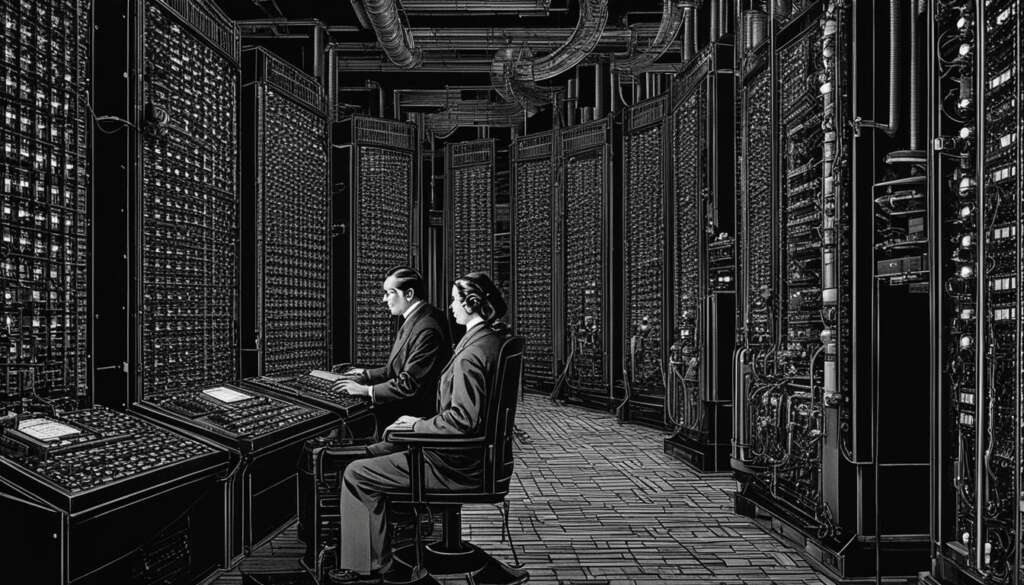Table of Contents
In the world of computing, ENIAC holds a unique place. It was the pioneering machine that revolutionized electronic computing forever. The significance of ENIAC in the history of computing cannot be overstated. It was the forerunner of modern computers and a giant leap in technological advancement.
Developed during the Second World War, ENIAC stood as a symbol of hope and technological progress. It was the first of its kind, a revolutionary machine that solved complex mathematical equations at an unprecedented speed. ENIAC heralded a new era of computing, one that captured the imagination of the world and transformed societies.
What is ENIAC? How did it function? What was the impact of this pioneering machine? These are some of the key questions we will delve into in this article. From its history to its legacy, we will explore the world of ENIAC and its significance in the field of electronic computing.
Key Takeaways:
- ENIAC was a pioneering machine that revolutionized electronic computing.
- ENIAC solved complex mathematical equations at an unprecedented speed.
- ENIAC was developed during the Second World War and had a major impact on various industries and fields.
- ENIAC heralded a new era of computing marked by technological advancements and innovation.
- We will explore the history and legacy of ENIAC in this article.
What is ENIAC?
ENIAC, short for Electronic Numerical Integrator And Computer, was the world’s first general-purpose electronic computing machine. It was developed in the mid-1940s at the University of Pennsylvania’s Moore School of Electrical Engineering by a team of talented engineers.
The main purpose of ENIAC was to calculate complex mathematical equations with unprecedented speed and accuracy. Prior to ENIAC, computing machines were primarily mechanical and relied on gears or levers to perform calculations. ENIAC, on the other hand, used vacuum tubes and electricity to execute instructions, making it the pioneering machine that transformed the field of computing.
ENIAC was an immense machine that spanned over 1,800 square feet and weighed more than 27 tons. It contained approximately 17,468 vacuum tubes, 1,500 relays, and 70,000 resistors. The machine’s size and complexity made it a challenge to operate, but its capabilities were unparalleled at the time.
The team of engineers behind ENIAC included John Mauchly, J. Presper Eckert, Arthur Burks, and many others. Their relentless efforts in developing the machine paid off, as ENIAC paved the way for future advancements in electronic computing.
Key Features of ENIAC
ENIAC was a remarkable machine that contained several key features which set it apart from earlier computing machines. Some of these features include:
- The use of vacuum tubes instead of mechanical switches, which allowed for faster calculations and more precise operations.
- The ability to store and retrieve instructions from memory, which reduced the need for manual programming and increased efficiency.
- The capability to perform a wide range of complex mathematical calculations, including multiplication, division, and square roots.
These features not only made ENIAC a groundbreaking machine but also laid the foundation for further technological advancements in the field of computing.
The Pioneering Machine that Revolutionized Technology
ENIAC was a landmark in the world of electronic computing, and its impact is still felt today. The machine revolutionized technology and altered the course of many industries and fields.
The electronic computing industry developed a rapid pace, thanks to ENIAC. The machine supplanted earlier computing models, which relied on mechanical switches and vacuum tubes, and paved the way for more sophisticated and powerful electronic computers. ENIAC’s impact on the scientific research industry was significant, with its computing power enabling researchers to complete complicated calculations in a matter of days, rather than years.
The military industry also benefited from ENIAC. During World War II, ENIAC was instrumental in calculating firing tables for artillery positions, which helped to predict the trajectories of shells accurately. ENIAC also played a role in code-breaking efforts, helping to decode secret messages. ENIAC’s impact on the military industry was so significant that it helped pave the way for advanced military technology, such as missile guidance systems and satellite technology.
“ENIAC was the first true electronic computer and a masterpiece of engineering – it set the stage for the computing revolution that followed.”
ENIAC’s influence on business operations was apparent as well. The first electronic computers, such as ENIAC, were primarily used for scientific and military purposes, but over time, they became indispensable in the corporate world. Electronic computers allowed businesses to process large volumes of data more quickly and accurately, which helped them to become more efficient and profitable.
ENIAC was more than just a groundbreaking machine – it was a game-changer. The machine’s influence can still be felt today, almost 80 years after its creation. ENIAC’s impact on electronic computing paved the way for more sophisticated and powerful machines, and its impact on the scientific research, military, and business industries has been undeniable.
Conclusion
In conclusion, ENIAC has played a significant role in the history of electronic computing and has shaped the course of technological advancements. Its pioneering capabilities have paved the way for modern computing as we know it today.
ENIAC’s contribution to the development of electronic computing is undeniable. It has enabled faster data processing, advanced scientific research, and enhanced military applications. The technology behind ENIAC has remained a foundation for subsequent generations of computers.
As technology continues to evolve, ENIAC will always be remembered as a groundbreaking invention that revolutionized the world. Its legacy will continue to inspire and motivate future generations of inventors and innovators.
In short, ENIAC’s impact on history and technology is immeasurable and will always remain a significant milestone in the field of electronic computing.
FAQ
What is ENIAC?
ENIAC, which stands for Electronic Numerical Integrator and Computer, was one of the earliest electronic computing machines. It was designed to perform complex calculations and solve mathematical problems.
When was ENIAC created?
ENIAC was created during World War II and was completed in 1945. It was commissioned by the United States Army to aid in artillery calculations.
Who were the engineers behind ENIAC?
ENIAC was designed and built by a team of engineers at the University of Pennsylvania. The main engineers involved in its creation were J. Presper Eckert and John W. Mauchly.
How big was ENIAC?
ENIAC was massive in size, filling an entire room. It comprised of over 17,000 vacuum tubes, weighed around 30 tons, and required a large amount of electricity to operate.
What were the key features of ENIAC?
ENIAC had several notable features, including its ability to perform calculations at a much faster rate compared to earlier machines. It also introduced the concept of stored-program computing, allowing the machine to be reprogrammed for different tasks.
How did ENIAC revolutionize technology?
ENIAC revolutionized technology by demonstrating the potential of electronic computing. It paved the way for the development of more advanced and powerful computers, leading to significant advancements in various industries such as scientific research, military operations, and business management.












